Illinois has many backyard birds that bring color and life to gardens and neighborhoods all year long. The state’s mix of forests, wetlands, and cities creates good places for lots of different birds. Learning about the common backyard birds in Illinois makes it easier to enjoy watching them.
This guide shows popular backyard birds in Illinois with clear pictures and simple tips to help you identify them. You will learn how to recognize their colors, behaviors, and sounds so you can spot them in your yard or nearby parks. Knowing more about these birds helps you appreciate the wildlife around you.
You will also find helpful ideas on how to attract and take care of backyard birds. By adding feeders or planting native plants, you can make your yard a safe and welcoming place for birds in Illinois.
Common Backyard Birds in Illinois
White-breasted Nuthatch
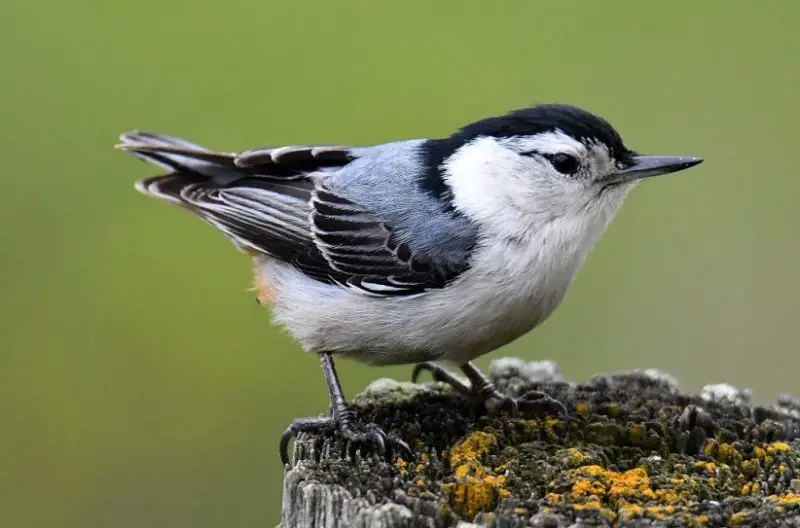
The White-breasted Nuthatch is a compact, agile bird known for its ability to move headfirst down tree trunks. It has a white face and underparts, a bluish-gray back, and a black cap that extends down the nape in males. Females have a similar appearance but may show a lighter crown or duller black.
This bird measures around 5.1 to 5.5 inches in length with a wingspan of about 7.9 to 10.6 inches. Its sharp, slightly upturned bill is perfect for prying insects from bark and crevices. Their call is a nasal “yank yank” that carries well through wooded areas, and their movement is quick and jerky as they forage.
White-breasted Nuthatches are found year-round across Illinois in deciduous forests, wooded parks, and residential areas with large trees. They frequently visit feeders for sunflower seeds, suet, and peanuts. During fall and winter, they may cache food in tree bark, often returning later to retrieve hidden seeds.
Northern Cardinal
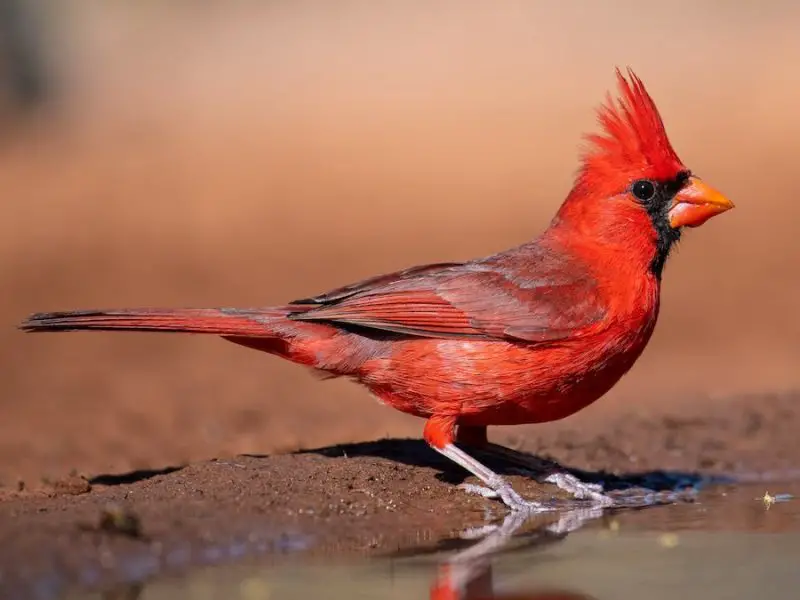
The Northern Cardinal is one of Illinois’ most iconic and recognizable birds, admired for its vivid coloration and melodic whistles. Males are a brilliant crimson red with a black mask around the face and throat, while females are a warm brown with reddish tinges on the wings and crest. Both sexes sport a prominent crest and a thick, reddish-orange beak.
Adult cardinals typically measure around 8.3 to 9.1 inches in length with a wingspan between 9.8 and 12.2 inches. Their stout bodies and rounded tails make them easy to spot, especially during the winter months when they stand out against snow-covered landscapes. Their sweet, whistled phrases often repeat and vary slightly, adding charm to any backyard.
Northern Cardinals thrive in a variety of habitats, including woodlands, suburban gardens, city parks, and forest edges throughout Illinois. They are non-migratory birds, which means they remain in the state year-round. These birds are frequent visitors at bird feeders, especially those offering sunflower seeds or safflower seeds.
American Robin
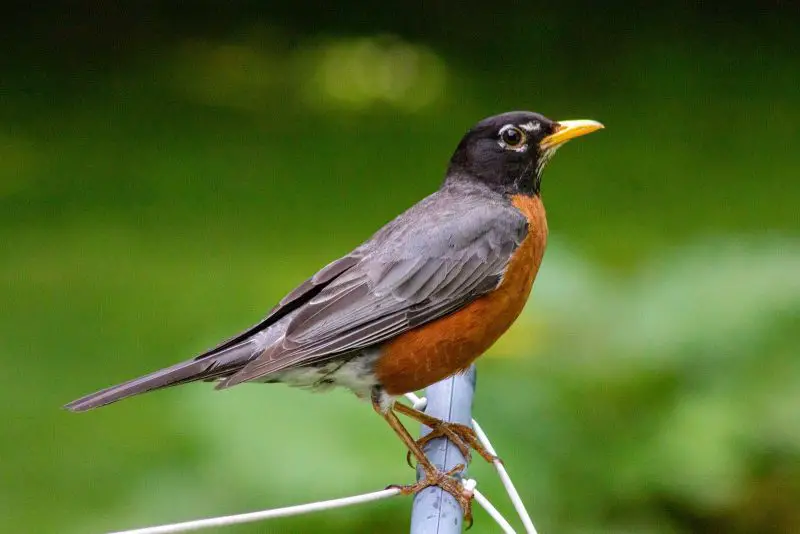
The American Robin is a familiar sight across Illinois, often seen hopping across lawns in search of earthworms. This species is known for its orange-red breast, gray-brown back, and bold white eye ring. Males and females look similar, though males tend to have slightly more vibrant coloration.
American Robins are medium-sized thrushes, measuring about 9.0 to 11.0 inches long with a wingspan of 12.0 to 16.0 inches. Their upright posture and distinctive, cheerful song make them easy to identify, especially during the breeding season. Their flight pattern is typically strong and direct, often punctuated by quick flaps.
These birds inhabit a wide range of environments, including forests, suburban neighborhoods, open fields, and city parks. In Illinois, American Robins are year-round residents in the southern parts of the state but are mostly summer breeders in the north. They build nests in trees or on structures and are among the first birds to start singing at dawn in spring.
American Goldfinch
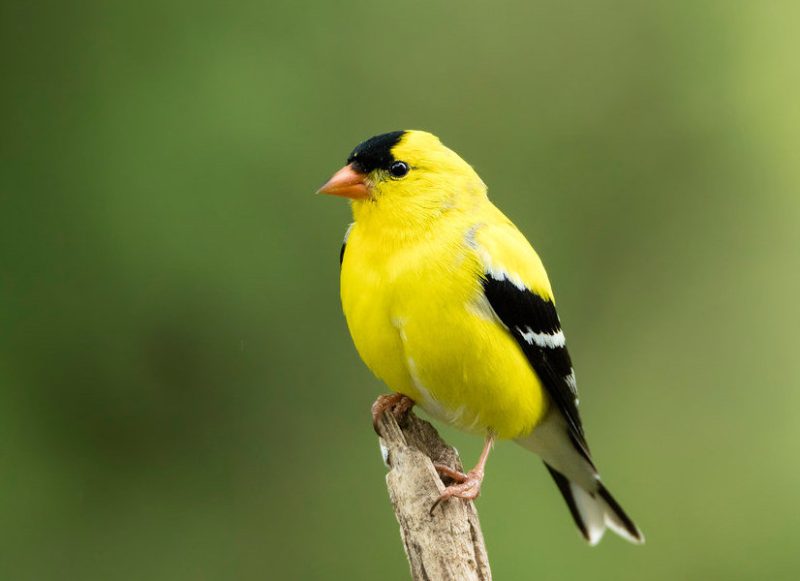
The American Goldfinch, Illinois’ state bird, is known for its bright, lemon-yellow plumage and cheerful song. Males are most striking in the summer, with black wings, a black cap, and vivid yellow bodies, while females and winter birds appear more muted with olive-brown tones.
These small finches measure about 4.3 to 5.1 inches in length and have a wingspan ranging from 7.5 to 8.7 inches. They have a conical bill, notched tail, and undulating flight pattern. Their sweet, tinkling calls often accompany their erratic flight as they move in flocks through weedy fields and backyard feeders.
American Goldfinches are common in Illinois throughout the year, though they are most noticeable during the summer months when males are in full breeding colors. They favor open habitats such as prairies, meadows, and weedy gardens. These birds are unique among finches for breeding later in the season, often waiting until thistle plants produce seeds.
Blue Jay
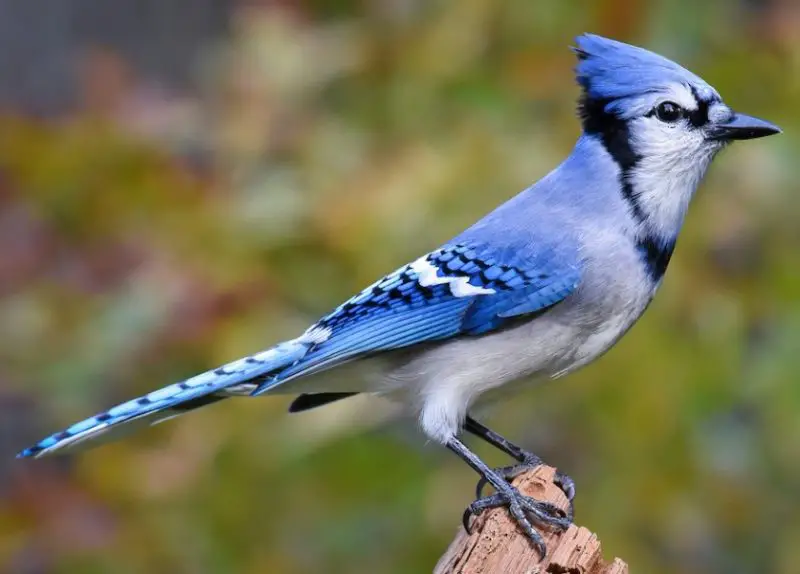
Blue Jays are intelligent and vocal birds, often heard before they are seen due to their loud “jay jay” calls and mimicry of hawks. They have a striking blue appearance with black-and-white markings, a prominent crest, and a sturdy black bill. The back and wings are a bright azure blue with black barring and white patches.
These birds are relatively large songbirds, measuring about 9.8 to 11.8 inches long with a wingspan between 13.4 and 16.9 inches. Their tail is long and rounded, and their flight is strong and steady. Blue Jays are known for their complex social behavior and ability to mimic the calls of other birds.
In Illinois, Blue Jays are common year-round residents in forests, woodlots, and suburban neighborhoods. They are especially fond of oak trees, where they collect and cache acorns for future consumption. These birds are frequent visitors to feeders, particularly those offering peanuts, suet, or sunflower seeds.
Mourning Dove
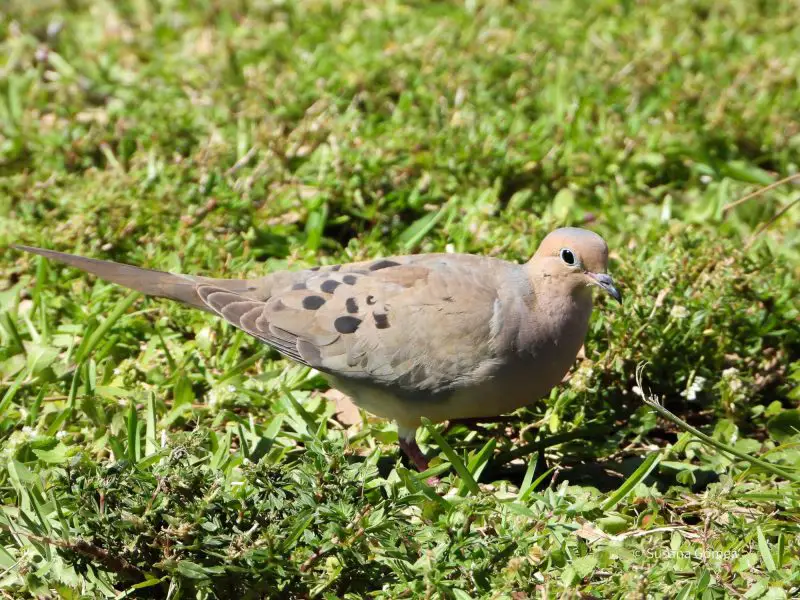
The Mourning Dove is a graceful, slender bird with a soft, mournful cooing call that echoes through Illinois neighborhoods and farmlands. It has a pale brown body, black spots on the wings, a long pointed tail edged with white, and a subtle pinkish hue on the chest. Its gentle demeanor and soft coloring make it a peaceful presence in many environments.
Mourning Doves are medium-sized birds, measuring around 9.1 to 13.4 inches in length with a wingspan of 17.7 inches. Their flight is fast and direct, with sharp wing whistles upon takeoff. They are ground foragers and often feed on seeds scattered on the soil surface.
In Illinois, Mourning Doves are found in both urban and rural areas year-round, favoring open fields, roadsides, parks, and backyard feeders. They often nest in shrubs or tree branches and may raise several broods in a single season. Their adaptability and tolerance of human presence make them one of the most widespread birds in the state.
Downy Woodpecker
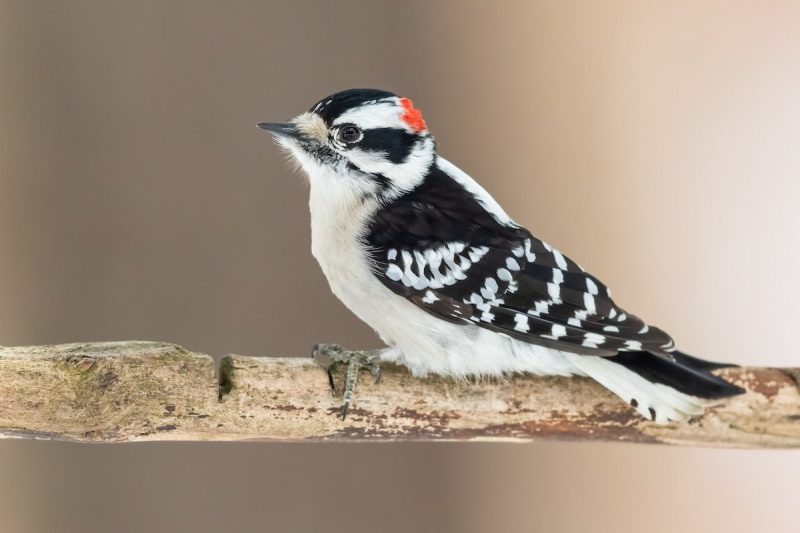
The Downy Woodpecker is the smallest and one of the most widespread woodpeckers in North America. Males have a small red patch on the back of the head, while both sexes feature black and white plumage with a distinctive white stripe down the back and spotted wings. Their short, chisel-like bill is smaller than that of most woodpeckers, helping to distinguish them from similar species.
These birds measure about 5.5 to 6.7 inches in length with a wingspan between 9.8 and 11.8 inches. They often cling to tree trunks and branches, tapping lightly as they forage for insects hiding beneath bark. Their drumming is relatively soft, and their high-pitched whinnying call is frequently heard in woodlands and suburban yards.
Downy Woodpeckers are year-round residents throughout Illinois, found in forests, orchards, parks, and backyard gardens. They are frequent visitors at suet feeders and will also eat sunflower seeds and peanuts. Their adaptability and small size allow them to thrive in both rural and urban areas, often nesting in tree cavities or dead limbs.
Red-bellied Woodpecker
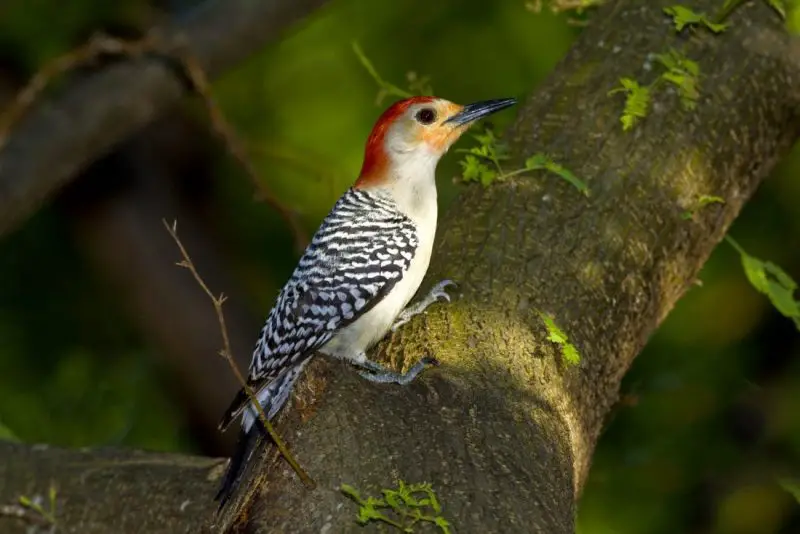
The Red-bellied Woodpecker is a medium-sized woodpecker known for its striking black-and-white barred back and a pale red blush on the belly, which can be hard to see. Males have a bright red cap that extends from the bill to the nape, while females have red only on the nape and a gray crown. Their faces are pale, and their bills are long and strong.
These birds are about 9.4 inches long with a wingspan between 13.0 and 16.5 inches. They are often mistaken for the Red-headed Woodpecker, but the Red-bellied’s red is limited to the crown and nape. Their rolling, chattering calls and loud “churr” sounds make them easy to detect even before they’re seen.
Red-bellied Woodpeckers are common throughout Illinois in woodlands, forest edges, and suburban yards with mature trees. They visit feeders for suet, nuts, and fruit, and they often store food in bark crevices. They excavate nest cavities in dead trees and are active all year, frequently seen climbing tree trunks in search of insects.
Black-capped Chickadee
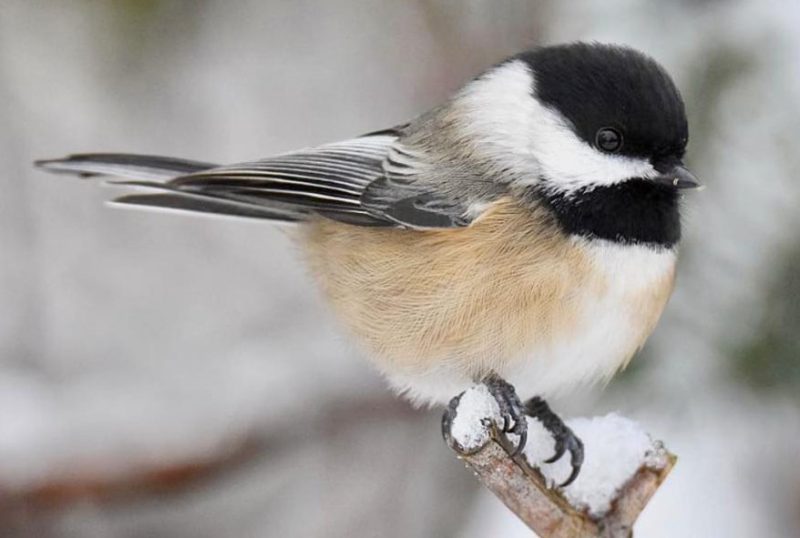
The Black-capped Chickadee is a small, sociable bird with a distinctive black cap and bib, white cheeks, and soft gray wings and back. Its underparts are a warm buffy color that fades to white toward the belly. This bird’s inquisitive nature and cheerful “chick-a-dee-dee-dee” call make it a favorite among backyard birdwatchers.
Adults measure between 4.7 and 5.9 inches long with a wingspan of about 6.3 to 8.3 inches. Despite their small size, they are very active and acrobatic, often seen hanging upside down from twigs while foraging. They are highly intelligent and capable of remembering food storage locations for weeks.
Black-capped Chickadees live year-round throughout Illinois, particularly in the northern and central parts of the state. They inhabit deciduous and mixed woodlands, parks, and suburban yards. These birds frequently visit feeders, especially those offering sunflower seeds, suet, and peanuts, and they may even eat from a hand when habituated to humans.
House Finch
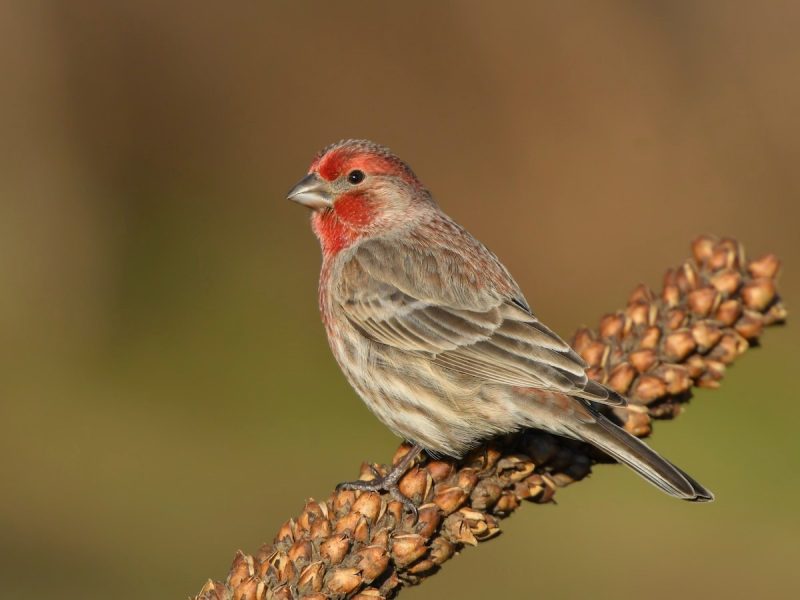
The House Finch is a common backyard bird with a cheerful song and an adaptable nature. Males are easily recognized by their red forehead, breast, and rump, while females are streaked brown and lack the red coloring. Their beaks are short and thick, well-suited for cracking seeds.
They range in size from 5.1 to 5.5 inches long with a wingspan of 7.9 to 9.8 inches. House Finches often gather in small flocks and sing a long, warbling tune that can be heard from rooftops, trees, or wires. Their movements are swift and fluttery, and they are very social, often feeding and flying together.
In Illinois, House Finches are permanent residents and thrive in both urban and rural environments. They are especially common around buildings, gardens, and feeders. These birds readily use nest boxes or ledges on buildings and are one of the most frequently observed birds at backyard feeders offering sunflower seeds.
House Sparrow
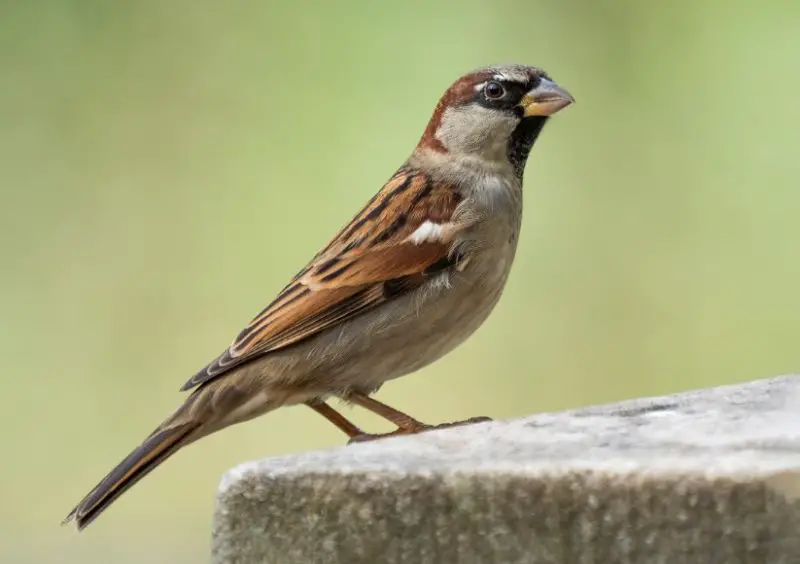
The House Sparrow is a small, stocky bird that thrives around human habitation. Males are easily recognized by their gray heads, black bibs, chestnut-brown napes, and streaked brown backs, while females are duller, with a more uniform brown and gray pattern and no black markings. Their sturdy, conical beaks are ideal for cracking seeds and grains.
These birds measure around 5.9 to 6.7 inches in length with a wingspan between 7.5 and 9.8 inches. They are very active, often seen hopping on sidewalks, perching on ledges, or fluttering in shrubs. Their chirping calls are frequent and loud, especially during social interactions or while nesting in colonies.
House Sparrows are non-native to North America but are now one of the most common birds throughout Illinois. They are highly adaptable and live in cities, towns, farms, and suburbs. They frequently nest in building crevices, vents, or street signs and are regular visitors at feeders offering grains, bread crumbs, or seed mixes.
American Crow
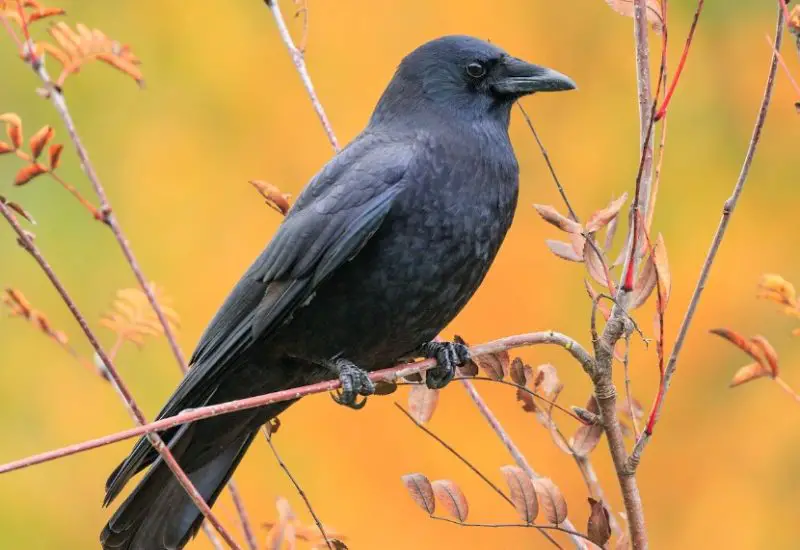
The American Crow is a large, glossy black bird known for its intelligence, loud “caw” calls, and complex social behavior. Its plumage, bill, legs, and eyes are all black, giving it a uniform appearance that can shine with iridescence in sunlight. It has a strong, heavy bill and a fan-shaped tail.
Crows measure about 16 to 20 inches in length with a wingspan between 33 and 39 inches. Their flight is steady and direct, with slow, deep wingbeats. American Crows are curious and problem-solving birds, capable of using tools, recognizing faces, and working in groups to find food or defend territories.
In Illinois, American Crows are found year-round in a wide variety of environments, from farmlands and forests to towns and cities. They feed on insects, grains, fruit, garbage, and even small animals or carrion. At dusk, large flocks often gather at communal roosts, particularly in winter, forming noisy gatherings that can include hundreds of individuals.
Common Grackle
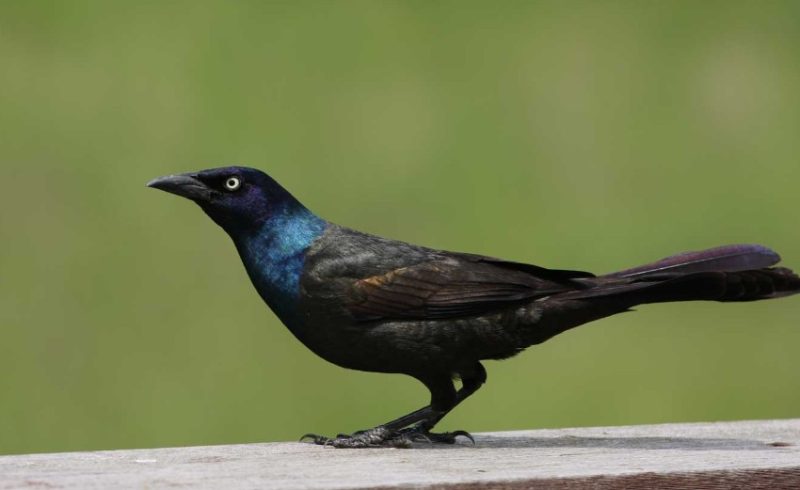
The Common Grackle is a bold, medium-to-large songbird with an iridescent sheen and striking yellow eyes. Males are especially glossy, with purplish heads and bronze-green bodies, while females are slightly duller with less iridescence. Their long tails are keel-shaped and appear V-shaped in flight.
Grackles are about 11 to 13 inches long with a wingspan between 14 and 18 inches. They walk confidently on the ground with long legs and a straight posture. Their calls are harsh, including squeaks and whistles, and they often gather in noisy flocks. Their feeding behavior is opportunistic and sometimes aggressive at bird feeders.
Common Grackles are widespread in Illinois during the breeding season and often remain through winter in southern areas. They prefer open woodlands, fields, wetlands, and urban spaces. These birds forage in lawns, farm fields, and trash bins, feeding on seeds, insects, grain, and occasionally small vertebrates.
European Starling
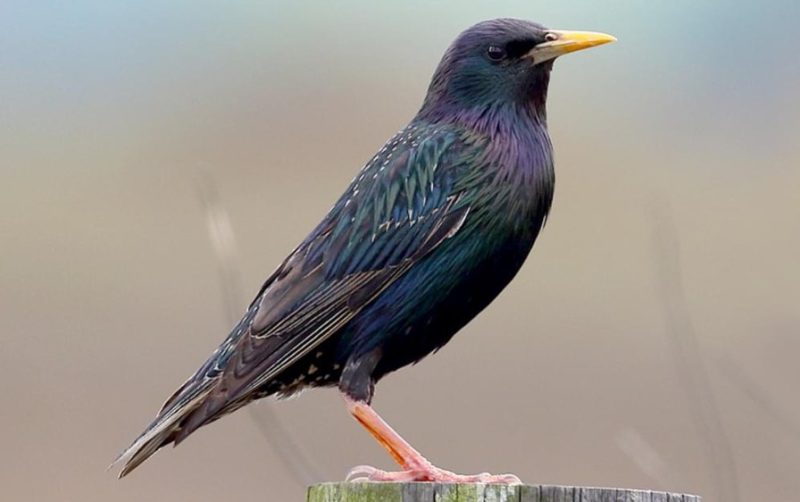
The European Starling is a highly adaptable bird with glossy, speckled plumage that changes with the seasons. In spring and summer, adults appear iridescent black with purple and green tones, while in fall and winter, their feathers show white spots. Their long, slender yellow bill turns dark in colder months.
Starlings are medium-sized, measuring about 7.9 to 9.1 inches in length with a wingspan between 12 and 15.8 inches. Their flight is fast and direct, often with short glides between rapid wingbeats. They are known for mimicking other birds’ calls and for their dense, swirling flocks called murmurations, especially during migration or roosting.
European Starlings are present year-round in Illinois and are commonly seen in cities, farms, parks, and suburbs. Originally introduced from Europe, they have become one of the most abundant birds in North America. They nest in cavities, buildings, and vents and frequently dominate feeders, especially those with suet or bread-based food.
Dark-eyed Junco
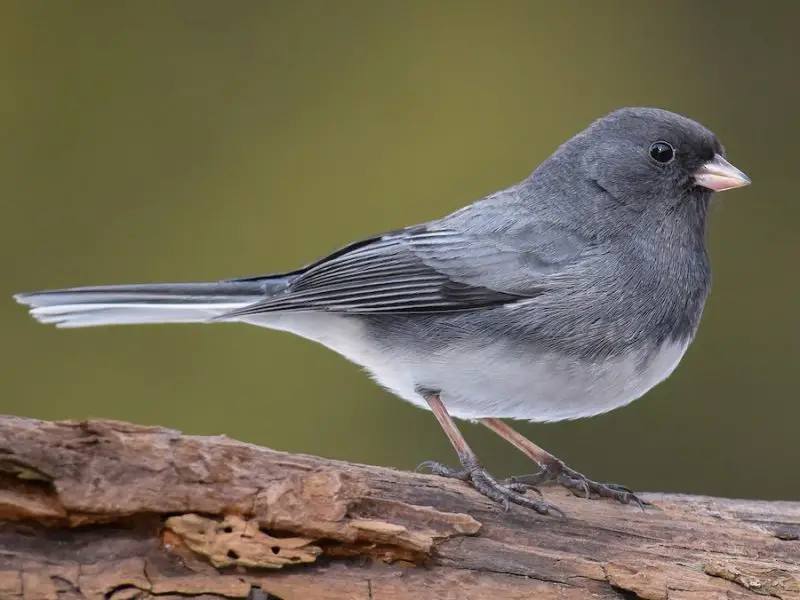
The Dark-eyed Junco is a small, round-bodied songbird with a distinctive color pattern that varies slightly by region. In Illinois, the most common form has a slate-gray head and upperparts, a white belly, and pinkish legs and bill. Females and juveniles tend to appear browner overall but still have the classic dark-eyed look.
These birds measure about 5.5 to 6.3 inches in length with a wingspan between 7.1 and 9.8 inches. They often feed on the ground, hopping briskly and flashing their white outer tail feathers during short, fluttery flights. Their call is a soft “tchick” and their song is a gentle trill that blends into the background of early spring woods.
Dark-eyed Juncos are most visible in Illinois during fall and winter, as they breed farther north and migrate south into the state for the colder months. They prefer forest edges, woodland clearings, parks, and suburban yards, especially where feeders and brush piles are available. These birds are commonly seen feeding on spilled seed beneath feeders.
American Tree Sparrow
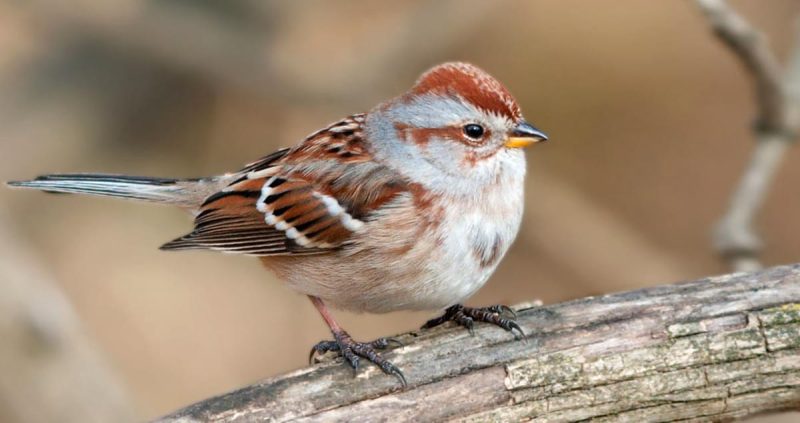
The American Tree Sparrow is a winter visitor to Illinois, known for its gentle appearance and subtle coloring. It has a rusty cap, gray face, and a chestnut eye line, with a small dark spot in the center of its pale breast. Its upperparts are brown with rusty streaks, and its bicolored bill is dark above and yellow below.
Tree Sparrows are medium-sized sparrows, about 5.5 to 6.7 inches long with a wingspan of 9.4 inches. They forage actively on the ground or low shrubs, often in loose flocks. Their high-pitched calls and soft musical whistles are typical sounds of quiet winter fields and thickets.
In Illinois, American Tree Sparrows are present only during the non-breeding season, typically from late October through early April. They favor weedy fields, open woodlands, hedgerows, and backyard feeding areas. They are frequent visitors to seed feeders and often feed on millet and sunflower chips scattered on the ground.
White-throated Sparrow
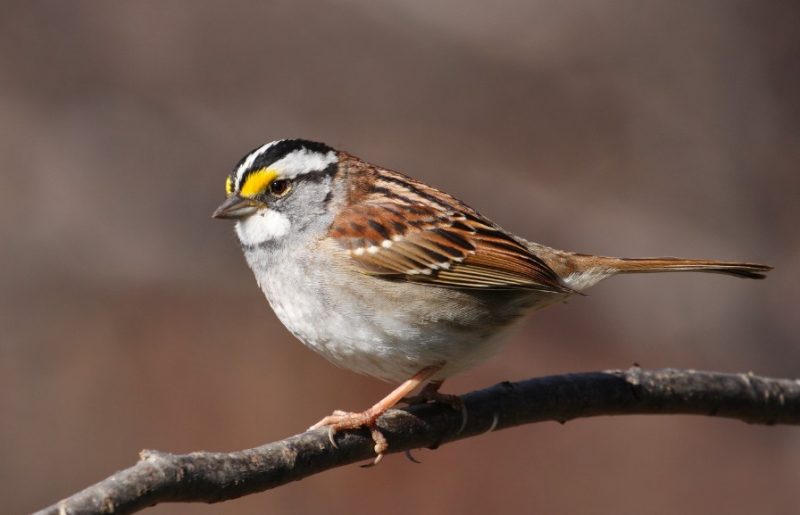
The White-throated Sparrow is a striking and melodic bird with a bold white throat patch, yellow lores in front of the eyes, and crisp black-and-white or tan head stripes depending on the individual. Its underparts are gray, and the back is streaked with brown, giving it a handsome but earthy appearance.
These sparrows range from 6.3 to 7.1 inches in length with a wingspan of about 8.3 to 9.1 inches. They forage by kicking backward in the leaf litter and may sing even in winter. Their song is a slow, whistled “Oh-sweet-Canada-Canada,” which is most often heard in the breeding season but may also be faintly heard in spring migration.
In Illinois, White-throated Sparrows are commonly seen during spring and fall migration and are abundant throughout winter. They favor brushy woodlands, forest edges, and thickets and often visit backyard feeders offering mixed seeds. Dense cover nearby is important, as they quickly dive into shrubs when startled.
Fox Sparrow
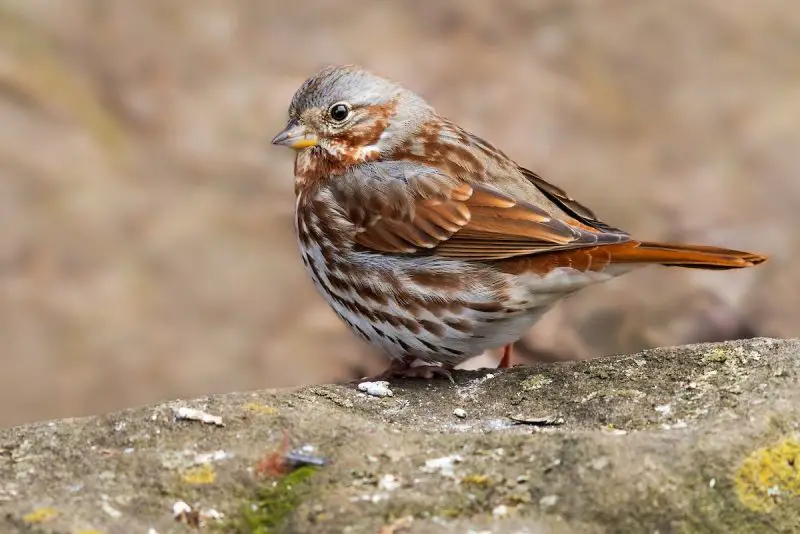
The Fox Sparrow is a large and robust sparrow with rich reddish-brown coloring and bold streaking on the breast that often forms a central spot. Its back and wings are a warm rusty red, and its face is gray with a rufous ear patch and mustache. This bird’s strong legs and thick bill give it a powerful look.
Measuring around 6.7 to 7.5 inches long with a wingspan between 10.5 and 11.4 inches, Fox Sparrows are larger than most other sparrows. They forage on the ground with vigorous double-scratching movements, often flicking leaves aside to uncover insects or seeds. Their call is a sharp “tchup,” and their song is rich and musical.
In Illinois, Fox Sparrows are most commonly seen during migration in spring and fall, though some linger into winter, especially in southern areas. They prefer dense thickets, brushy forest edges, and areas with leaf litter. Though not as frequent at feeders, they may visit if there is ample ground seed and nearby cover.
Indigo Bunting
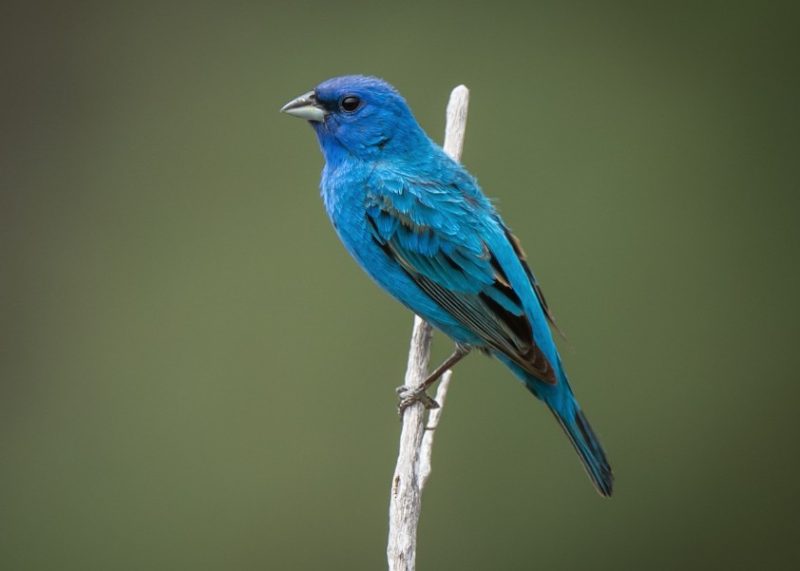
The Indigo Bunting is a small, dazzling songbird best known for the vibrant blue plumage of breeding males. In bright sunlight, males appear almost electric blue all over, while females and nonbreeding males are brown with subtle hints of blue on the wings and tail. Their conical bills are short and pale, suited for cracking seeds.
These birds measure about 4.7 to 5.1 inches in length with a wingspan of 7.5 to 8.7 inches. Males sing a cheerful, warbling song from exposed perches like treetops or power lines during the breeding season. Their flight is bouncy, and they often forage low in shrubs or tall grasses for seeds, berries, and insects.
In Illinois, Indigo Buntings are seen from late spring through early fall in shrubby fields, woodland edges, roadsides, and overgrown pastures. They migrate at night and spend winters in Central America and the Caribbean. These birds are attracted to native plants, and they may visit feeders offering nyjer or millet.
Gray Catbird
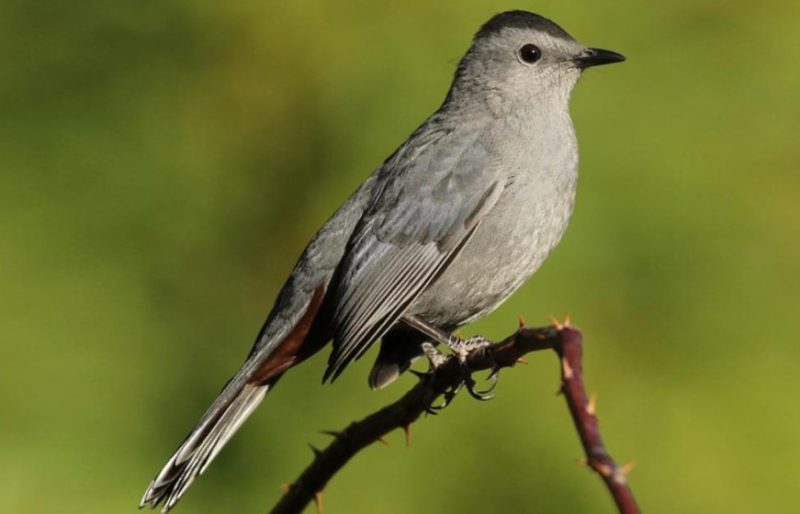
The Gray Catbird is a sleek, medium-sized songbird with slate-gray plumage, a black cap, and a rusty patch under the tail. It is named for its cat-like “mew” call, which is often heard from dense shrubs. The bird’s overall appearance is smooth and clean, with dark eyes and a long, rounded tail.
Gray Catbirds are about 8.3 to 9.4 inches long with a wingspan between 8.7 and 11.8 inches. They are members of the mimic thrush family and are known for their varied and complex songs that mimic other birds and environmental sounds. When foraging, they stay low in vegetation, searching for insects and berries.
In Illinois, Gray Catbirds are summer residents, commonly found in dense thickets, hedgerows, suburban gardens, and forest undergrowth. They are secretive but curious and may approach feeders with fruit, raisins, or mealworms. Their presence is often given away by their distinctive vocalizations and active tail movements.
Barn Swallow
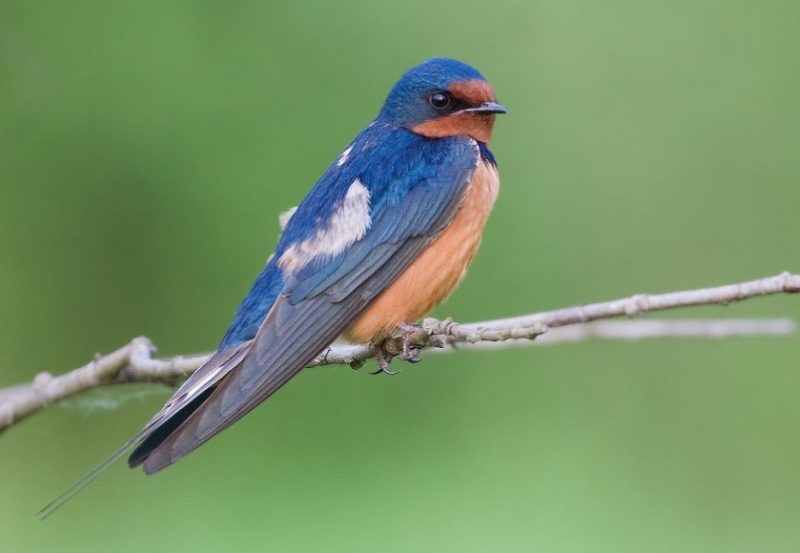
The Barn Swallow is a graceful, agile bird with a deeply forked tail and long, pointed wings. Its upperparts are glossy blue, while the throat and forehead are rich chestnut, and the underparts are a pale orangish buff. The long outer tail feathers give the bird a distinctive silhouette in flight.
These birds measure about 5.9 to 7.5 inches in length with a wingspan between 11.4 and 12.6 inches. They are expert aerial foragers, often seen swooping over open fields, ponds, and pastures as they catch flying insects on the wing. Their song is a series of cheerful twitters and chirps.
Barn Swallows breed throughout Illinois from spring through late summer, favoring open habitats with access to structures like barns, bridges, and sheds for nesting. They build cup-shaped mud nests under overhangs or beams and often return to the same site year after year. These birds migrate to Central and South America for the winter.
House Wren
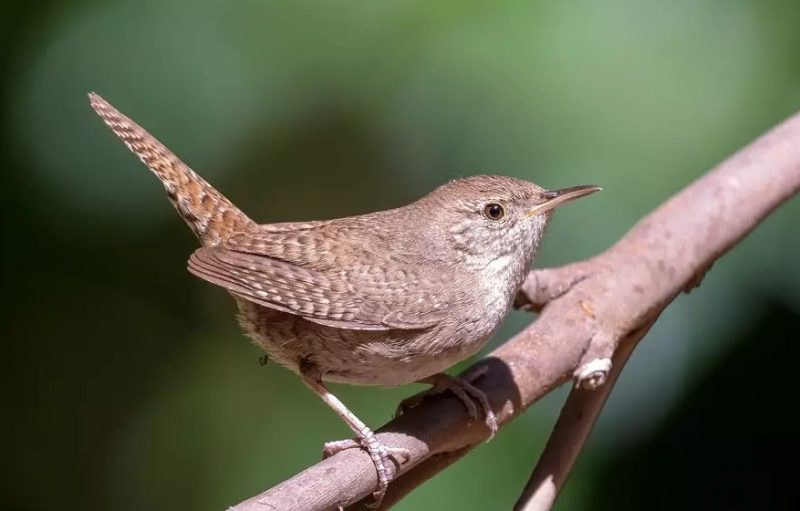
The House Wren is a small, energetic brown bird with a bubbly personality and an even more lively song. Its plumage is plain brown with fine barring on the wings, tail, and flanks. It has a faint eye line and a thin, slightly curved bill that helps it capture insects in tight spaces.
House Wrens measure around 4.3 to 5.1 inches in length with a wingspan of 5.9 inches. Their song is a loud, gurgling series of trills and chatters, often delivered from a perch or the entrance of a nest cavity. These birds are highly active and often seen hopping through bushes and shrubs or popping out of nest boxes.
In Illinois, House Wrens are common from spring through early fall in gardens, parks, woodlots, and suburban areas. They readily use nest boxes and will often compete with other cavity nesters for space. Their diet consists mainly of insects and spiders, making them helpful in controlling garden pests.
Tree Swallow
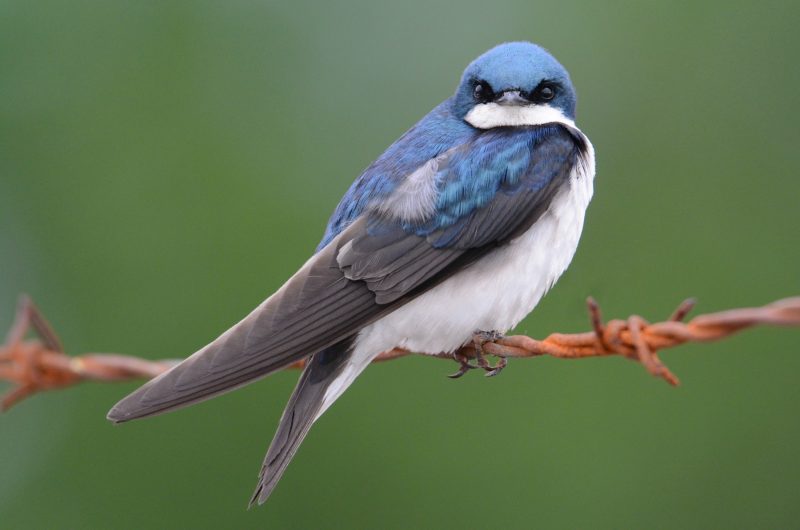
The Tree Swallow is a sleek and graceful bird with shimmering blue-green upperparts, clean white underparts, and long, pointed wings. Its small bill, short tail, and iridescent plumage make it easy to distinguish from other swallows. Juveniles and females are duller, often with brownish upperparts and less shine.
These birds measure about 5.1 to 5.9 inches in length with a wingspan between 11.8 and 13.8 inches. Tree Swallows are agile fliers, often seen swooping over fields and ponds in pursuit of flying insects. Their song is a soft, twittering series of chirps and liquid trills, often heard while they’re gliding in the air or perched near nest sites.
In Illinois, Tree Swallows are common during the breeding season, especially around wetlands, lakes, and open meadows with nearby nesting boxes or tree cavities. They readily use man-made nest boxes near water and often return to the same nesting area each year. These birds migrate to Central America and the southern U.S. during winter.
Eastern Wood-Pewee
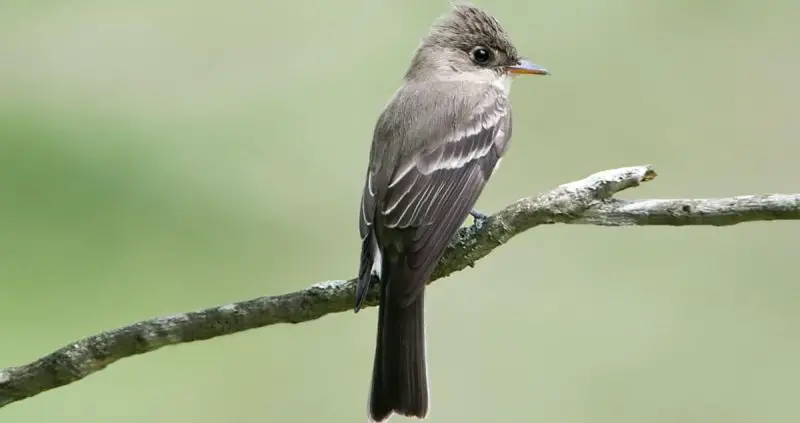
The Eastern Wood-Pewee is a small flycatcher with olive-gray upperparts, pale underparts, and two faint wingbars. It has a slender bill with an orange lower mandible and a slightly peaked head that gives it a distinct profile. Unlike some similar species, it lacks bold eye-rings and shows more contrast between throat and belly.
It measures about 5.9 inches long with a wingspan of 9.1 inches. Eastern Wood-Pewees are often heard before they are seen, delivering a plaintive, whistled “pee-a-wee” song from high in the canopy. They hunt by sallying out from a perch to snatch insects midair and then returning to the same spot.
In Illinois, Eastern Wood-Pewees are summer residents of deciduous forests, wood edges, and shaded parks. They prefer mature trees for nesting and foraging and are often seen perched quietly in the understory. As migratory birds, they spend winters in Central and northern South America.
Ruby-throated Hummingbird
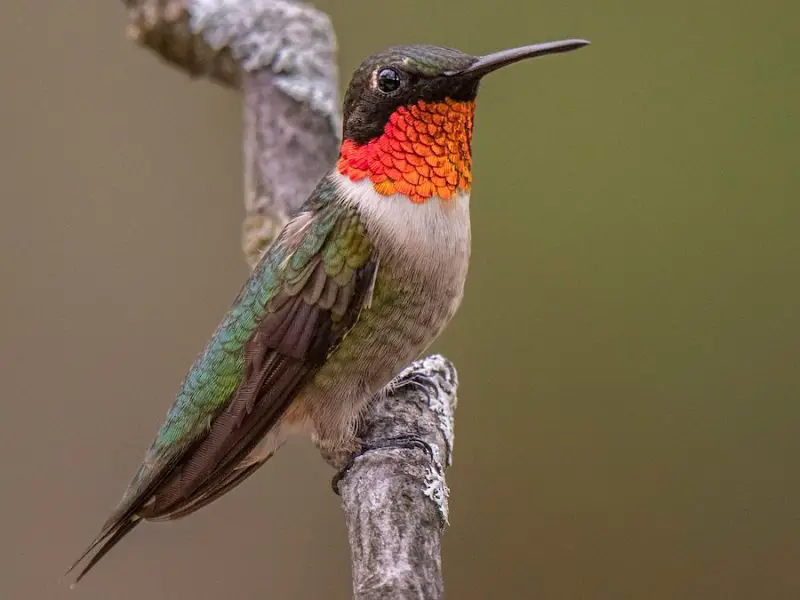
The Ruby-throated Hummingbird is the only breeding hummingbird species in Illinois and is known for its iridescent beauty and fast, agile flight. Males are easily identified by their metallic green backs and bright ruby-red throats, which can appear black in certain lighting. Females lack the red throat and have white underparts with greenish flanks.
These tiny birds are about 2.8 to 3.5 inches long with a wingspan of 3.1 to 4.3 inches. Their wings beat incredibly fast, allowing them to hover in place while feeding on nectar. They also eat small insects and spiders for protein, especially during the breeding season. Their wings produce a soft humming sound during flight.
Ruby-throated Hummingbirds are summer visitors in Illinois, arriving in late spring and departing in early fall. They prefer gardens, forest edges, and areas with flowering plants. Hummingbird feeders with sugar water (no red dye) are effective in attracting them. These birds migrate long distances, often crossing the Gulf of Mexico in a single flight.
Cedar Waxwing
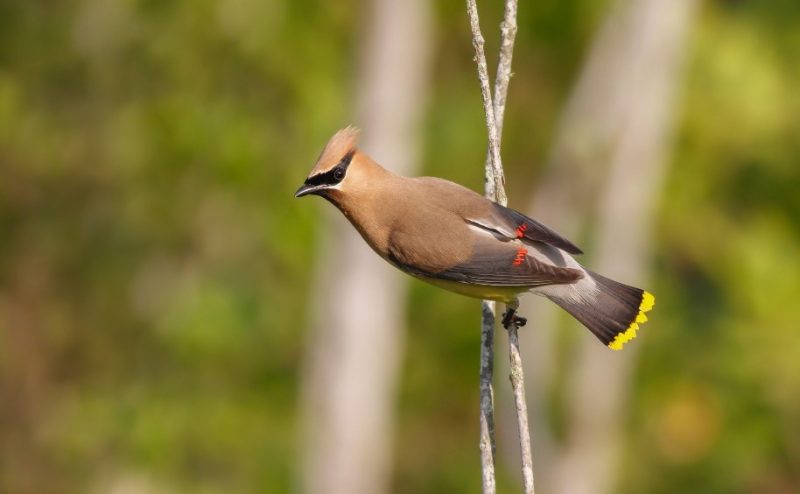
The Cedar Waxwing is a sleek, elegant bird with silky plumage, a pale brown head fading to soft gray on the wings, and a lemon-yellow belly. It has a distinctive black mask edged in white, a short crest, and red waxy tips on its secondary wing feathers, which give the species its name. The tail is tipped with bright yellow.
Cedar Waxwings are medium-sized songbirds, measuring 5.5 to 6.7 inches in length with a wingspan between 8.7 and 11.8 inches. They are highly social and often seen in flocks, flying in coordinated groups or feeding together in trees and shrubs. Their calls are high-pitched, buzzy trills that often blend into the background.
In Illinois, Cedar Waxwings are found year-round in some areas, though many migrate farther north to breed and return in large flocks during fall and winter. They prefer woodlands, orchards, and suburban landscapes with abundant berries. These birds are known for their fruit-heavy diet and will often pass berries to one another as part of courtship behavior.
FAQ About Backyard Birds in Illinois
What are the most common backyard birds in Illinois?
Many common backyard birds can be seen across Illinois throughout the year. Species like the Northern Cardinal, American Robin, Downy Woodpecker, Blue Jay, and House Sparrow are frequently spotted in residential areas. During migration seasons, visitors such as White-throated Sparrows and Dark-eyed Juncos also appear.
When is the best time to watch backyard birds in Illinois?
Birdwatching can be enjoyed year-round in Illinois, but spring and fall are especially active due to migration. During these seasons, you’ll see both resident and migratory birds in backyards and gardens. In winter, feeders attract species like juncos, finches, and woodpeckers, while summer brings hummingbirds, wrens, and buntings.
What should I put in bird feeders in Illinois?
To attract a variety of birds, offer a mix of black oil sunflower seeds, suet, nyjer (thistle) seed, and peanuts. For hummingbirds, use sugar water in a nectar feeder (1 part sugar to 4 parts water). Avoid bread, salted foods, and dyed nectar, as they can harm birds. Ground-feeding birds may also appreciate millet scattered near shrubs.
Do birds stay in Illinois during the winter?
Yes, many birds remain in Illinois throughout the winter. Year-round residents include Northern Cardinals, Chickadees, Nuthatches, Mourning Doves, and Woodpeckers. These species rely on backyard feeders, natural berries, and sheltering trees or shrubs to survive the cold months.
How can I make my backyard more bird-friendly?
Plant native shrubs and trees that offer food and shelter, such as serviceberry, dogwood, and oak. Include a clean birdbath or shallow water source for drinking and bathing. Providing feeders and keeping cats indoors also increase the safety and attractiveness of your backyard for birds.
Are hummingbirds found in Illinois backyards?
Yes, the Ruby-throated Hummingbird is the only species of hummingbird that breeds in Illinois. It visits backyards from late spring through early fall. These birds are drawn to red or orange tubular flowers and nectar feeders. They migrate to Central America during the winter.
What birds visit Illinois during migration?
Many birds pass through Illinois during spring and fall migration, including Warblers, Thrushes, Sparrows, and Kinglets. Some less common backyard visitors during migration include the Fox Sparrow, Harris’s Sparrow, and Rose-breasted Grosbeak. Migration peaks typically occur from April to May and again from September to October.
Can I feed birds year-round in Illinois?
Yes, feeding birds year-round is both safe and beneficial, especially during winter and early spring when natural food sources are limited. Just be sure to keep feeders clean and stocked with appropriate food for the season. In warmer months, reduce suet use to prevent melting and spoilage.
What types of habitats attract the most backyard birds?
Birds are attracted to backyards that offer a combination of food, water, shelter, and nesting sites. Trees, dense shrubs, open lawn space, and native flower beds create layers of habitat that support diverse bird activity. Quiet environments with minimal pesticide use are also more attractive to birds.
Are any birds in Illinois aggressive at feeders?
Yes, some species can be territorial at feeders. House Sparrows, Common Grackles, and European Starlings are known to dominate feeding stations and chase smaller birds away. To manage this, try using feeders designed for smaller birds or placing multiple feeders in different areas of your yard.

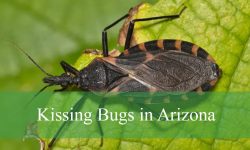
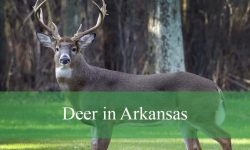
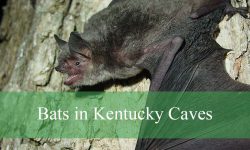

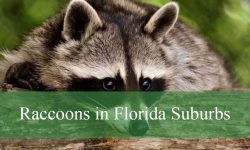
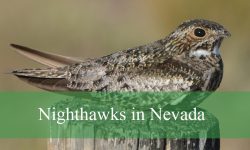
Excellent review of species I’ve missed for a long time since retirement and moving to a less bird-rich community.